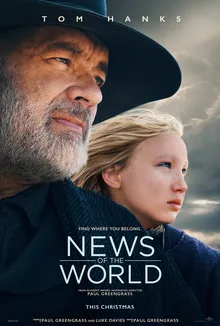Historical accuracy of News of the World

Historical accuracy of News of the World

Characters
The characters are fictional
All the characters are fictional
The character of Captain Kidd
Captain Jefferson Kidd is a fictional character. While the film is set in a real historical context, Kidd's story and his specific experiences are a work of fiction.
The rescue of Johanna
Johanna's story, including her capture by Kiowa and her subsequent rescue, is a fictional narrative. While such events could have occurred, they are not based on a specific historical individual or incident.
Story
The story is fictional
Setting
Post-Civil War Texas
The film accurately portrays the lawless and chaotic environment of post-Civil War Texas. This period was marked by significant social and political upheaval, which the film effectively captures.
The role of news readers
The practice of reading news aloud to audiences was common in the 19th century, particularly before widespread literacy and the availability of newspapers. The film's depiction of this practice is historically accurate.
The treatment of Native Americans
The film depicts the harsh treatment of Native Americans during this period, including their displacement and mistreatment by settlers and the government. This is a historically accurate portrayal of a tragic chapter in American history.
The journey across Texas
The journey undertaken by the characters across Texas, while fictional, reflects the challenges and dangers of travel in the 19th century. The vast distances, difficult terrain, and potential for encounters with outlaws or hostile groups were all realities of the time.
The political divisions of the time
The film hints at the lingering political divisions and tensions following the Civil War. This was a real and significant aspect of the Reconstruction era, and the film's portrayal, though subtle, is accurate.
The use of period language
The film's dialogue and language generally reflect the style and vocabulary of the 19th century. This contributes to the film's sense of historical authenticity.
The depiction of towns and settlements
The film portrays various towns and settlements in Texas. While some aspects are accurate, others may be romanticized or simplified for cinematic purposes. It is difficult to determine the absolute historical accuracy of every single town shown.
The role of the US Army
The presence and role of the US Army in post-Civil War Texas, particularly in relation to Native American affairs, is accurately depicted. The army's involvement in controlling the frontier was a historical reality.
The prevalence of outlaws
The film suggests the presence of outlaws and bandits in the post-Civil War West. This was a real and significant problem during this period, and the film's portrayal is consistent with historical accounts.
The challenges of communication
The film highlights the challenges of communication in the 19th century, with news traveling slowly and often being unreliable. This was a real constraint on people's lives and is accurately depicted.
The landscape of Texas
The film showcases the diverse landscape of Texas, from wide-open plains to more rugged terrain. This is a generally accurate representation of the state's geography.
